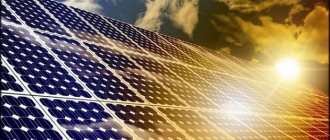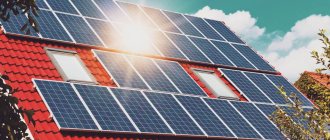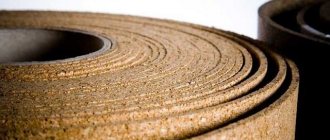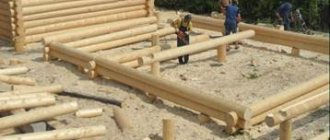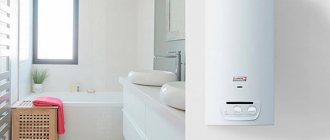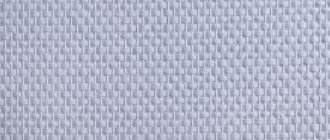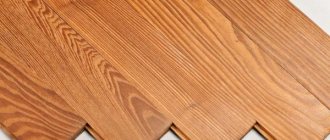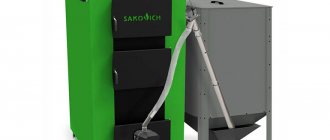Register Login
Publication date: May 3, 2019
The creation of the first samples of amorphous film batteries became a new discovery in the field of alternative sources of electrical energy. Over the course of several years, the model was improved, achieving outstanding technical and operational characteristics from a simple design. Experts involved in energy research say that very soon amorphous solar panels will take a leading position in their segment and will be put into mass production.
Description
At this time they are already represented by the third generation. The advantage of the second is considered to be low cost with power identical to crystalline modules. Therefore, they are the ones that have become widespread. Silicon required to produce them is 10 times less.
Models belonging to the third generation are characterized by an increased operating period and efficiency increased to 12%.
Important: photovoltaic modules, thin-film modules are considered the main candidate for mass production, possible in the near future, despite the shortcomings and the fact that today the leadership is held by crystalline analogues (80% of the market).
Comments:
Megavolt
I read that they released solar batteries in the shape of a round cone, they produce 20% more than conventional batteries. Does anyone know about this technology?
Electrician
Megavolt, let's calculate))) The efficiency of film batteries (namely, they are rolled into a cone) = 10%. We add 20% of 10% to them and get as much as 12% with an increase in cost of at least three times! Breakthrough in savings!
Semyon
Electrician, I also watched this story. It immediately seemed suspicious to me that the entire scientific breakthrough consisted of giving batteries some kind of shape. As if no one had guessed before that the sun was out of place... As always - conspiracy theories and collusion.
Leave a comment Cancel reply
Related Posts
Types of solar-powered garden lamps and lanterns, how and where to use them.
Photo manual: DIY solar battery step by step
Windmill for a private home - a toy or a real alternative
How to choose a solar panel - overview of important parameters
Generations of amorphous panels
Very soon, the rapid development of amorphous film modules may change the current market situation.
Today they are represented by three generations:
- The first category includes single-junction ones, the disadvantage of which was their short service life: after 10 years of operation they became unusable. In addition, their efficiency was extremely low - 5%;
- they are the same, but with twice the efficiency (8%) and a longer service life;
- third-generation devices can fully compete with analogues, since they have a fairly high efficiency - about 12%. They will last much longer than their predecessors.
In addition to them, there are combined options that form both crystalline and amorphous elements. However, their cost is high, so they are not widely used.
Vacuum method
In principle, any approach can be used, for example, ion sputtering, but all methods have their own difficulties, such as the formation of a film both on the substrate and on the inner surface of the chamber. Another difficulty is associated with the supply of indium, which is actively used for the manufacture of flat panel monitors.
Although panels of this type are actively developing, their demand is small and does not exceed 2%.
Films made using cadmium telluride have gained great popularity. Their efficiency is 16% (versus 18%). Amorphous silicon batteries are very popular. Their efficiency was increased to 10%.
Advantages
Thin-film amorphous panels have many advantages over their crystalline counterparts:
- better performance at high operating temperatures. Due to their lesser dependence on heat, they are more efficient than crystalline ones in warm weather. It is clear that they lose power when heated, but not as much as conventional solar panels, for which it can be reduced by 20%.
They are capable of generating electricity in low light conditions, therefore they are more effective in comparison with their crystalline counterparts in rainy weather, twilight and snowfall.
Amorphous systems continue to generate electricity when classical crystalline structures stop generating it. They produce 20% more of it than their analogues.
- allow hidden installation;
- cost less because production costs are low. The favorable cost of each Watt is also explained by the injection of significant investments, which makes it possible to increase their output and reduce the price;
- high flexibility and low thickness make installation, repair and maintenance easier;
- less dependent on shading and dirt on the front surface, while the performance of silicon devices is reduced by 25%;
- Minimum defects. The process of creating the modules in question is very simple. Due to the absence of the need for soldering to connect the modules to each other (they are formed immediately into a single structure), there are fewer defects in the finished products.
The disadvantages, as you can see, are more than offset by the advantages of the panels.
Myth 6: Excess electricity is stored in the system
Fact: This is true, but the amount of accumulated electricity is limited by the depth of charge of the batteries. In practice, connecting an alternative energy system to power grids in Russia and Ukraine is practically impossible. In Europe and the USA, energy generation into the grid is common. If the system is connected to the electrical grid, you can feed excess energy into the local power grid, charging bonuses to your account. If you need a large amount of electricity at night (when the system is not working), you can use electricity from the network completely free of charge. This is done automatically, so users don't even notice the switch. We hope that soon we will also simplify the procedure for connecting to networks.
Disadvantages of amorphous modules
The main negative feature of amorphous silicon solar cells is considered to be low efficiency, which is half that of silicon analogues (under conditions close to ideal).
In addition, they have other disadvantages:
- significantly larger dimensions than analogues;
- protected on both sides by glass, they acquire a significant final mass. The disadvantage, by the way, is gradually leveled out thanks to the development of technology.
Silicon panels have no less disadvantages.
Reviews
Reviews from owners who use panels as a source of electricity are mixed. On the one hand, having an autonomous system that does not depend on outside interference is quite convenient. On the other hand, there are very few regions in our country whose solar activity would be sufficient for the battery system to become the main one.
Therefore, when installing such a source, you have to think about additional, backup systems, which leads to additional costs.
Although, with the development of new technologies, the lack of sun rays no longer affects the efficiency of batteries so much, so over time, more and more people become consumers of useful solar energy.
Disadvantages of Silicon Devices
This material is very expensive, since for the required degree of purification it needs to go through several stages of purification. When cutting it, a large amount turns into waste - chips.
In addition, not all energy is converted into electrical energy under the influence of light: it is partially reflected back from the surface, the other part, without being absorbed or converted, passes “outside”.
We recommend:
- Solar panels work at night and in cloudy weather
- Monocrystalline solar panels: comparison with analogues, advantages, price - TOP-6
- Thin-film solar cells: advantages and disadvantages, price, characteristics
In addition, it can lead to thermal vibrations in the crystal lattice and is wasted on the recombination process, i.e. destruction of electrons with “holes”, which is accompanied by the release of heat.
All this negatively affects the efficiency of solar cells, reducing it to 15% (in rare cases to 22%).
How to assemble a solar battery at home?
If, after studying the information presented above, the desire to start making a solar battery has not disappeared, you can experiment by creating and testing your own creation. Next, the assembly of a panel from monocrystalline wafers will be discussed in detail.
In the example shown, a home craftsman assembles a panel with dimensions of 750x960 mm, consisting of 36 rigid monocrystalline plates measuring mm. The plates are installed in four rows, with 9 photocells in each. A gap of about 10÷12 millimeters is maintained between the photocells.
| Illustration | Brief description of the operations performed |
| Illustration | Brief description of the operations performed |
| To work, you will need, first of all, the plates themselves. The wizard recommends purchasing them with a reserve, since they may have different output voltage parameters, and from them you will need to select 36 pieces that have the values closest to each other. The busbar is a tinned copper strip, that is, already coated with tin, which simplifies its soldering. You will need about 10 meters of a narrow tire with a width of 1.6 mm and 2 meters of a wide one with a width of 5 mm. For electrical work, you need to prepare a regular 40 W soldering iron. soldering flux is rosin dissolved in alcohol, alcohol for degreasing surfaces for soldering and their subsequent cleaning from flux residues, cotton pads and swabs. In this case, acrylic glass 5 mm thick is used as the basis for mounting the entire module. For subsequent sealing of the photocells, the master decided to use durable colorless transparent polyvinyl chloride film ORACAL®751, which is often used to attach advertising to vehicles. | |
| A few words about why the tire width of 1.6 mm was chosen. Metal tends to expand when heated, and when cooled, accordingly, contract. On a solar battery, this process will occur constantly, that is, during the day the soldered busbars will increase in size, and at night - on the contrary, which is not particularly useful for the design. The master tested a tape with a width of 2 mm, and still chose a width of 1.6 mm. In terms of conductive qualities, these buses do not differ much from each other, and the narrower one is still less susceptible to linear deformation. | |
| Having prepared everything you need, it makes sense to first sort the plates. As mentioned above, despite the fact that this is one model, they can often have different indicators in practical work. And for the battery to operate harmoniously, the generated voltage values must be as close to each other as possible. For example, in this case, during the test it was discovered that photocells under equal conditions (under artificial lighting) can produce from 0.19 to 0.35 volts. It is better if elements that have the closest possible values, say, from 0.30 to 0.33 volts are collected in one panel. If one or two elements are installed in the complex, significantly different in output voltage, then they will create unnecessary resistance and will begin to overheat. Thus, plates that clearly fall out of the total mass are rejected. | |
| When installing the plates, a gap of 10÷12 mm will be left between them. It is needed so that the film that fixes the elements on the acrylic glass holds them on all sides. | |
| Next, you need to place two plates on the table at a distance of 10 mm, and use them to measure how long the narrow tires need to be cut. As you can see, on the outer side of the fastening plates there are two metal current-collecting strips, and on the reverse side of it, the fixation points are indicated dotted with windows. | |
| On the front side of the plate, it is necessary to retreat approximately 3 mm from its upper edge. | |
| On the back side of the second panel, the bus should also not reach the bottom edge by the same 2÷3 mm. | |
| After determining the length of one connecting bus, the remaining connecting elements are measured along it. For every two plates you will need two pieces of tire, that is, a total of 72 pieces are needed. When cut, the tires look as shown in the photo. It is not at all necessary to prepare all the segments at once - they can be cut as you go. However, if they are prepared all at once, it is recommended to collect them and secure them with an elastic band. This way they won’t get lost and won’t get in the way on the table. | |
| First, the busbars are soldered to the front side of all the plates. But before soldering, the metal current-collecting strips on the plates must be prepared by degreasing with alcohol. For this work, it is convenient to use cotton swabs - they are dipped in alcohol and passed over the strip. This process is necessary to improve the quality of soldering. | |
| The next preparatory stage is applying rosin flux to strips cleaned with alcohol. It is better if it is poured into an elastic container in the form of a marker (glue stick) with a soft tip. This will make it easier to work, if necessary, squeezing out and distributing the required amount of composition. | |
| The next step is to solder the busbars to the outside of the plates. The bus is placed on a metal contact strip and leveled. Next, holding most of the busbar, carefully pressing it against the strip, its upper side is fixed with a soldering iron at 20–30 mm in length. Additional solder is not used - a layer of tinning on the bus itself is sufficient. Now it is fixed and will not be able to move, so it will be quite easy to secure its remaining long side to the surface. | |
| To do this, the plate must be turned towards you with the opposite side, so that the long part of the tire is at hand. Holding the bus and pulling it slightly, carefully run the soldering iron over it, making sure that it does not slip to the side. Tinned tape is easily soldered to a properly prepared surface - it is enough to run a well-heated soldering iron over it once without haste. If burrs remain on the tape, they must be smoothed out immediately, since this side of the plates must be pressed against the acrylic glass. | |
| Having soldered both tapes to the plate, they must be wiped with alcohol using a cotton swab or disk. All remaining flux must be removed from the surface. | |
| In the same way, all 36 wafers, or only 9 solar cells, are sequentially prepared to assemble one of the four strips of the solar panel. Here each master does what is most convenient for him. | |
| Next, we will consider the assembly of prepared photocells into one strip. The remaining three strips of the solar panel are connected in the same way. | |
| First, a plate is taken that will be the first in the strip. It is placed face down on the table, along with the tires soldered to it. Then the solder strips, highlighted on the back side of the plate with contact windows, are treated with alcohol and then with flux. Next, stepping back from the edge by about 3 mm along a line passing through the windows, a section of the bus is laid and soldered to the surface using the same method as on the outside. The free ends of the buses should be located in the opposite direction relative to those soldered to the front surface - they will be needed when switching the entire series of elements into a common battery with wide buses. | |
| Now you need to connect the first and second plates of the row together. To do this, the ends of the bus bars soldered to the front side of the first plate must be brought out to the back side of the second plate. The plates are placed parallel to each other at a set distance (10 mm). For convenience, you can make markings on the desktop in advance, that is, make a kind of template for the relative position of the plates. | |
| The contact soldering points are treated with alcohol and then flux is applied to them. | |
| Now you can solder the busbars. To do this, also carefully, slowly, run a heated soldering iron over them. After finishing soldering both busbars, they also need to be wiped with alcohol to remove the remaining flux. | |
| Next, the third and all subsequent plates of the row are switched in the same way. The result should be four strips of 9 photocells, connected as shown in the illustrations. | |
| Ready-made, soldered rows of photocells are placed one by one on pre-prepared acrylic glass of the required size. A distance of 50÷60 mm must be maintained from the edges of the elements to the edge of the glass. The rows are temporarily fixed on the glass with short strips of transparent tape. | |
| The “golden rule” of sequential switching of DC power supplies: the plus of the previous element is connected to the minus of the next one - and so on. This rule is observed in the ranks. Now it is very important not to disturb it when laying rows in the battery. Thus, the sections of the first and third row tires protruding from the left must be soldered on the outer side of the panel, which in this case is turned towards the acrylic surface. In the second and fourth rows, the ends of the tires should protrude, fixed on the back light side of the plates. If you make a mistake, the serial connection will be broken and the battery will not work. | |
| As a result, the design of the laid panel should look like this. When all the rows are secured to the glass with tape, they must be combined into one system. | |
| The electrical connection is made according to the diagram presented. As a result, there will be a “plus” on top and a “minus” on the bottom. | |
| Wide busbars are used as connecting elements - this is clearly shown in the diagram above. The protruding ends of thin tires are soldered to them. After soldering, the excess should be cut off with pliers. | |
| This photo clearly shows the extreme point of bus commutation. Having completed the work, the panel must be checked for functionality using a tester, switching it to a voltmeter and setting the probes to plus and minus. | |
| The panel can be checked first on the desktop - there will not be large indicators, but the assembled panel will demonstrate that it is “live”. And then you can test it by taking the battery out into the sun. | |
| The multitester probes are attached to the outer positive and negative tires. | |
| Even in cloudy weather at idle, the battery produces 19.4 volts - this indicates that the panels are connected correctly. | |
| There was no sun at the time of testing, and the current was small, only about 0.5 amperes. But even in cloudy weather, the battery produces about 10 watts of energy. | |
| At the same time, it is recommended to check the plates for overheating - it’s easy to feel it with the back of your hand. If individual plates against the general background are clearly overheating, then it is advisable to replace them immediately - this is not difficult to do for now. | |
| If the battery works normally, then you can finally seal it - roll it in film. The service life of this film is seven years, but as practice shows, it functions well even longer. The film has an adhesive layer covered with a protective backing, which is removed as the coating is glued to photocells and acrylic glass. | |
| The first thing to do is to lay the film on top of the structure and align the edge from which it will begin to be glued. The quality of gluing of the entire canvas depends on how aligned the edge is. Complete sealing must be achieved, without folds or voids, since the film is designed to reliably protect photocells from any external influences. | |
| Next, you need to carefully separate the protective layer from the film along the entire edge, by about 40 mm, immediately securing it to the glass. | |
| This operation is carried out very carefully; when gluing, the film is leveled and smoothed. Here you need to remember that peeling off and leveling a certain section of the film will no longer work, so you need to do the job efficiently right away. The film should not be stretched, but at the same time it should not bunch up. | |
| The protective backing is folded down and gradually removed as it is glued. Having released 20÷30 mm of the film, it is smoothed onto the photocells and the gaps between them, that is, onto the acrylic glass. | |
| The process of rolling the battery in film is long and painstaking, so you need to be patient and do it slowly. If the film still gets wrinkled or goes to the side, it cannot be peeled off, as the photocells will be damaged. In this case, it is necessary to cut out and paste an additional fragment on top of the already attached film. The main thing is to cover the entire surface of the battery. This illustration shows the edge of the panel rolled up in film. It is clearly seen that perfect smoothness is not required, the main thing is a tight fit of the film over the entire area. | |
| Once the film is pasted, you can test the finished panel. To do this, you need to take the battery out into the sun and connect the tester to it again. | |
| As you can see, the battery produces an output voltage of almost 20 volts. Then the short circuit current is checked - it was 3.94 amperes. And this is neither more nor less – almost 80 watts. | |
| To check under load, a 24 V light bulb was connected to the battery through an ammeter. The result in the photo is that it burns, although not at full intensity, but quite brightly. |
Many craftsmen, in addition to glass and film, also use battery framing, placing it in a rigid frame. This gives the structure the necessary strength and increases its reliability.
If you plan to assemble and use several solar panels, then they are connected either in series - to increase the output voltage, or in parallel - this way you can achieve higher current and total power
The panel complex is connected through a controller to a battery - an energy storage device, and from it distribution is made to points of consumption, directly or through an inverter.
Find out how to make a solar collector with your own hands from our new article on our portal.
* * * * * * *
So, as you can see from the information presented, the battery can be assembled with your own hands. You will need some knowledge of electrical engineering and installation, perseverance and attentiveness.
Another thing is that you should first very carefully weigh the expected effect of the battery and the cost of components and all equipment necessary for the system. How profitable will the system be, especially taking into account local climatic conditions? Will its creation simply turn into a “toy” for an active middle-aged man?
Perhaps the video below will answer some questions about this:
Area of use
It is recommended to use this type of solar modules for:
- high cloudiness;
- hot weather, when the modules heat up to 60 degrees;
- no restrictions on the area of the structure and its weight;
- if necessary, integration directly into the building.
In addition, amorphous solar panels can be installed in window openings (instead of glass) and mounted on building facades, which opens up unlimited possibilities for designers. But, the elements must differ in a certain degree of transparency (for glass it is 5-20%, without losing a percentage of electricity generation).
From flat to cylindrical
Cylindrical solar panels were first developed by a small American company with the catchy name Solyndra (from the words “solar” and “cylinder”). They presented their achievement in 2008 and immediately received several large orders from European and American companies. According to them, this figure was more than $1 billion.
Until 2008, solar cells were flat in shape. Solyndra proposed installing cylinder elements in solar panels. A thin layer of photocell is applied to the surface of a glass tube, after which it is placed in another similar tube, but with electrical contacts. The already familiar copper, gallium, selenium and indium are used as semiconductors for elements. Cylindrical solar panels, due to their shape, absorb more light and, as a result, have a higher performance indicator. Each panel consists of 40 cylinders and measures 1 by 2 meters.
To increase the absorbed light, it is recommended to use cylindrical batteries in combination with a white roof covering. In this case, the rays reflected from the roof will pass through the cylinders, which will provide another plus 20% of the absorbed energy
Another important advantage of batteries with cylindrical elements is their resistance to strong winds. They can withstand wind gusts of up to 200 km/h
This makes installation of solar panels easier and cheaper.
Manufacturing
Only thoroughly purified silicon is suitable for the manufacture of a semiconductor converter. Its shape, as a rule, is a cylinder with a diameter of only tens of millimeters.
It is cut into the thinnest disks, microns in thickness, which are then alloyed, applying metal and other impurities to the surface.
In a silicon wafer, areas are formed that are saturated differently with “holes” and electrons. In other words, having “hole” p-conductivity and n-electronic conductivity.
By “holes” we mean a metal from which electrons have been partially removed by impurities, i.e. this is the “positive” zone, or p-conductivity.
By combining the composition, the order of the applied layers and their thickness, hetero- or pn-junctions are obtained, i.e. The plates have the ability to produce electricity when irradiated with light.
Based on this principle, the first FETs were created - photoelectric converters, the efficiency of which reached almost 30% under normal conditions and about 22% at high temperatures.
Varieties
According to the method of functioning, solar systems are divided into two types:
- Autonomous. They work where there is no possibility to connect to the central power grid. The disadvantage occurs during periods of prolonged absence of sun (for example, in winter), when there is a risk of being left without electricity. They need backup with a diesel/gasoline generator.
In winter, snow can become a hindrance Source domvpavlino.ru
Production of amorphous FEP
The raw material for the main layer is silane-silicon hydrogen (SiH4). After treating silicon with hydrogen, hydrogenated silicon is obtained.
In a closed chamber, the silane is exposed to a glowing electrical discharge before being applied to amorphous silicon. Evaporating, silicon vapors are deposited on the substrate. The layer is micron thick.
Since the production is waste-free, the cost of the finished product is low. Modules can be made with an area of several square meters.
Hydrogenation achieves semiconductor properties in the thinnest films.
Price
- Panels based on amorphous silicon have the lowest cost. Based on the calculation of the total cost of the system, the price per 1 W will be from 0.8 to 1.0 dollars.
- The cost of 1 W when using panels based on micromorphic silicon will be 1.0-1.3 dollars.
- Batteries based on polycrystalline silicon will cost between 1.1-1.4 dollars per 1 W.
- The most expensive are products based on monocrystalline silicon. In this case, the cost will be about $1.5 per 1 W.
Where can I buy
You can purchase solar panels either in a specialized store or online in an online store. In the second case, the budget option for purchasing products on the Aliexpress website deserves special attention. For some panels there is an option for shipment from a warehouse in the Russian Federation; they can be received as quickly as possible; to do this, when ordering, select “Delivery from the Russian Federation”:
| Mini solar panel with voltage from 2 to 12 Volts | 100 Watt 12 Volt Flexible Solar Panel | 300 Watt Flexible Solar Panel Set |
| Dokio Portable Solar Panel 18V 200W | Lamp with built-in solar panel power supply | Polycrystalline solar panel 40 Watt, 18 Volt |
Why efficiency is so important
Efficiency comes into play when calculating the amount of space you can use for a solar panel system. With comparable sizes of the described modules from Amerisolar AS-6P30 280W (1.63 square meters) and NeOn 340 W from LG (1.71 square meters), the difference in power per square meter at the output will be 15.6%. On the one hand, this may not seem very effective, given the price difference of more than double, but in the case of limited space or a more aggressive external environment, it may shift your choice in favor of this well-known manufacturer.
The increased efficiency emphasizes not only the efficiency of the manufacturing technology, but also the high-quality materials used in manufacturing. This can affect the operating life of the devices and the resistance of the panels to so-called degradation. Don't forget about the manufacturer's warranty. Having representative offices and warranty services in almost every corner of the world, LG will be able to boast a more loyal approach to customers and fulfillment of its obligations.
Kinds
Today, various types of solar panels are gaining increasing popularity. At first glance, it may seem that all solar modules are the same: a large number of individual small solar cells are interconnected and covered with a transparent film. But, in reality, all modules differ in power, design and size. And at the moment, manufacturers have divided solar systems into two main types: silicon and film.
For domestic purposes, solar panels with silicon photocells are installed. They are the most popular on the market. Of which three types can also be distinguished: polycrystalline, monocrystalline, which have already been discussed in more detail in the article, and amorphous, which we will dwell on in more detail.
Amorphous - also made on the basis of silicon, but, in addition, they also have a flexible elastic structure. But they are not produced from silicon crystals, but from silane - another name for hydrogen silica. Among the features of amorphous modules, we can note their excellent efficiency even in cloudy weather and the ability to replicate any surface. But the efficiency is much lower - only 5%.
The second type of solar panels is film, produced on the basis of several substances.
- Cadmium - such panels were developed back in the 70s of the last century and were used in space. But today cadmium is also used in the production of industrial and domestic solar power plants.
- Modules based on CIGS semiconductor are designed from copper indium selenide and are film panels. Indium is also widely used in the production of liquid crystal monitors.
- Polymer – also used in the production of solar film modules. The thickness of one panel is about 100 nm, but the efficiency remains at 5%. But one of the advantages is that such systems have an affordable price and do not emit harmful substances into the atmosphere.
But also today there are less bulky portable models on the market. They are specially designed for use during outdoor activities. Often, such solar panels are used to recharge portable devices: small gadgets, mobile phones, cameras and video cameras.
Portable modules are divided into four types.
- Low-power - they provide a minimum charge, which is enough to recharge a mobile phone.
- Flexible - they can be rolled up and are light in weight, which is why they are very popular among tourists and travelers.
- Fixed on a substrate, they weigh significantly more, approximately 7-10 kg and, accordingly, provide more energy. Such modules are specially designed for use on long car trips, and can also be used to partially autonomously supply energy to a country house.
- Universal – indispensable for hiking, the device has several adapters for simultaneous charging of various devices, weight can reach 1.5 kg.
